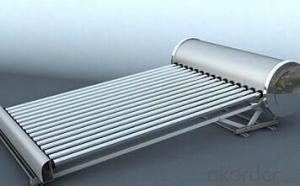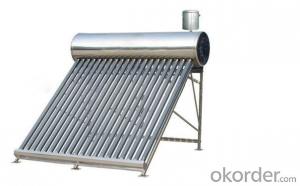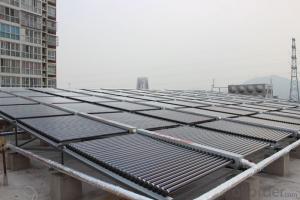Alpine TX Solar Collectors Copper Heat Pipe Solar Water Heater System
- Loading Port:
- China main port
- Payment Terms:
- TT OR LC
- Min Order Qty:
- 1 set
- Supply Capability:
- 6000 set/month
OKorder Service Pledge
OKorder Financial Service
You Might Also Like
Introduction of Non-Pressure Solar Water Heater:
Non-pressure Solar Heater is one of the most economical solar water heating device with pretty high efficiency at the same time. It consists of hot water storage tank, solar vacuum tubes with mouth plug in storage tank, and bracket supporting tank and tubes.When cold water in evacuated tubes is heated with solar irradiation, as the specific gravities of hot water and cold water are different, hotter water goes upward to storage tank and colder water goes downward to glass tubes. through this continuous circulation, the cold water in storage tank will be gradually heated till sunset.
Specialty:
1. High thermal performance and working temperature: the heat exchanging rate even in winter can up above 55%.
2. Heat collecting efficiency is at least 20% above common solar systems.
3. Work in all day and all season: no matter any corner of the world, this system can work well even -40℃ to avoid the tube freezing problem.
4. Reliability: No water following through the tube, so water scale can not generate and tube cracks could be avoided, the system still can keep working even with some damaged tubes.
5. It can connect with water tap and work automatically with pressure0.6Mpa, bring enjoyable washing experience.
6. Safety: P/T valve would release pressure and temperature to protect tank..
Technical Specification:
1. Outer tank material: SUS304 stainless steel or powder coated color steel
2. Inner tank material: 1.2mm thick SUS304 food grade stainless steel ( Optional material SUS316L)
3. Vacuum tube material: borosilicate glass 3.3; AL-SS-CU absorb coating, with copper heat pipe inside
4. Frame material: 1.2mm thickness stainless steel
5. Insulation material: 55mm thickness polyurethane
6. Suitable for mains pressure water(up to 8 bar/116psi)
7. Easy plug-in installation
8. Install the T/P valve on the pressurized tank
9. Seal material: Stabilized High Temperature Silicon
Outer tank material: SUS304 stainless steel or powder coated color steel
Inner tank material: 1.2mm thick SUS304 food grade stainless steel ( Optional material SUS316L)
Vacuum tube material: borosilicate glass 3.3; AL-SS-CU absorb coating, with copper heat pipe inside
Frame material: 1.2mm thickness stainless steel
Insulation material: 55mm thickness polyurethane
Suitable for mains pressure water(up to 8 bar/116psi)
Easy plug-in installation
Install the T/P valve on the pressurized tank
Seal material: Stabilized High Temperature Silicon
19. Vacuum Tube | 20. Size (mm) | 21. Φ47*1500 / Φ58*1800 / Φ70*2100 | |||||
22. Tube (pcs) | 23. 10 / 12 / 15 / 18 / 20 / 22 / 24 / 30 / 36 / 42 | ||||||
24. Material | 25. Borosilicate 3.3 glass, magnetron spluttering selective coating | ||||||
26. Coating | 27. Single-target AL-N/AL or Three-target AL/N-Cu-SS | ||||||
28. Water Tank | 29. Capacity | 30. 80L ~ 500L for hot water storage tank | |||||
31. Inner tank | 32. Food-grade stainless steel SUS304-2B / SUS316 | ||||||
33. Insulation | 34. High-density polyurethane foam with 70~80 hour heat preservation | ||||||
35. Tank shell | 36. Food-grade stainless steel SUS304-2B | ||||||
37. Bracket | 38. Shaped strong aluminum alloy structure adaptable for flat or slope roof | ||||||
39. Accessories | 40. Anti-aging silicon seals, Dustproof seals, Air-vent cap, Stainless screws | ||||||
41. Auxiliary Devices | 42. Assistant tank, Intelligent controller, Electrical heater, Magnesium anodes | ||||||
43. Tilt Angle | 44. 25 ~ 50° | ||||||
45. Water Output | 46. 45 - 95°C | ||||||
47. Hail Resistance | 48. Φ25mm diameter | ||||||
49. Model Number | 50. Solar Vacuum Tube | 51. Tank 52. Liter | 53. System 54. Liter | 55. Container Loading Qty /sets | |||
56. Size /mm | 57. Qty /pcs | 58. 20GP | 59. 40GP | 60. 40HQ | |||
61. VNS-58SA12-100 | 62. Φ58*1800 | 63. 12 | 64. 100 | 65. 132 | 66. 58 | 67. 119 | 68. 140 |
69. VNS-58SA15-130 | 70. 15 | 71. 130 | 72. 170 | 73. 54 | 74. 108 | 75. 131 | |
76. VNS-58SA18-150 | 77. 18 | 78. 150 | 79. 198 | 80. 43 | 81. 86 | 82. 105 | |
83. VNS-58SA20-170 | 84. 20 | 85. 170 | 86. 223 | 87. 40 | 88. 80 | 89. 97 | |
VNS-58SA24-200 | 24 | 200 | 263 | 35 | 70 | 85 | |
VNS-58SA30-250 | 30 | 250 | 329 | 28 | 56 | 68 | |
VNS-58SA36-300 | 36 | 300 | 395 | 23 | 47 | 57 | |
Product Show



Our Services
1. OEM service
2. Warranty: 5 years
3. Considerable after sale service
Color steel Compact pressure Thermal solar heater
FAQ:
1. What’s the delivery time?
10 days after receiving deposit.
2. How long is the warranty?
5 years for whole system, 1 year for accessory
3. What’s your production capacity?
6000sets/month
4. What’s the MOQ?
1 set.
5. What’s your payment term?
Container: 30% T/T in advance for deposit, 70% T/T before shipment for fist order.
70% T/T after seeing copy of B/L from second order
Sample: 100% T/T in advance
Other choices: L/C at sight.
6. What certifications do you have?
CE, SOLAR KEYMARK, SRCC and etc.
- Q: Can solar collectors be integrated into existing buildings?
- Yes, solar collectors can be integrated into existing buildings. They can be installed on rooftops or walls, depending on the available space and orientation. Retrofitting solar collectors onto existing buildings is a viable option to harness solar energy and reduce reliance on traditional energy sources.
- Q: What is the average payback period for a solar collector installation?
- The average payback period for a solar collector installation typically ranges between 5 to 10 years, depending on factors such as the initial cost of installation, energy savings, and government incentives.
- Q: Can solar collectors be used for drying household appliances?
- Using solar collectors for drying household appliances is not possible. Solar collectors are specifically designed to capture sunlight and convert it into heat energy. This heat energy can be utilized for heating water or generating electricity. However, it is not effective for drying household appliances as the temperature produced by solar collectors is generally not sufficient for this purpose. To efficiently dry clothes or other items, household appliances like clothes dryers require a much higher temperature and specific airflow. Therefore, alternative methods like air drying or using specialized drying appliances would be more appropriate for drying household appliances.
- Q: How do solar collectors perform in coastal areas?
- Solar collectors perform well in coastal areas due to the abundant sunshine and the cooling effect of the ocean breeze, which helps to enhance their efficiency.
- Q: How much energy can solar collectors generate?
- Solar collectors can generate a significant amount of energy if properly designed and utilized. The amount of energy that solar collectors can generate depends on several factors such as the size and efficiency of the collectors, the available sunlight, and the location of the collectors. On average, solar collectors can generate around 1,000 kilowatt-hours (kWh) of electricity per year for every square meter of collector area in ideal conditions. However, this can vary widely depending on geographical location and weather patterns. In regions with abundant sunlight and minimal shading, solar collectors can generate even more energy. For example, in sunny regions like the southwestern United States, solar collectors can generate up to 2,000 kWh per year for every square meter of collector area. It is important to note that solar collectors not only generate electricity but can also produce hot water for residential or commercial use. The amount of hot water that solar collectors can generate depends on the size of the system and the specific needs of the user. In conclusion, solar collectors have the potential to generate a significant amount of energy, ranging from 1,000 to 2,000 kWh per year per square meter of collector area. This renewable energy source can contribute to reducing reliance on fossil fuels and mitigating the impact of climate change.
- Q: Can solar collectors be used in refugee camps?
- Yes, solar collectors can be used in refugee camps. They provide a sustainable and renewable source of energy for various purposes such as lighting, heating, cooking, and charging electronic devices. Solar collectors help alleviate the energy crisis in camps, reduce reliance on fossil fuels, and improve living conditions for refugees by providing access to clean and reliable energy.
- Q: Can solar collectors be used in fuel cell power plants?
- Yes, solar collectors can be used in fuel cell power plants. Solar collectors can generate electricity by converting sunlight into direct current (DC) electricity, which can then be used to power fuel cell systems. The combination of solar collectors and fuel cells can provide a sustainable and efficient source of electricity for power plants.
- Q: Can solar collectors be used for generating electricity on elevators?
- Using solar collectors to generate electricity on elevators presents several considerations. Firstly, efficient electricity generation requires direct sunlight, but elevators are typically enclosed within buildings or shafts, limiting sunlight availability. The constant movement of elevators also creates shadows, further reducing exposure to sunlight. Additionally, solar collectors are typically installed on rooftops or open areas to capture maximum sunlight. Mounting them on elevators would require specific engineering and design considerations to ensure proper positioning and orientation for adequate sunlight. Continuously adjusting the position and angle of the solar collectors would also be necessary to optimize their efficiency as the elevator moves. Furthermore, the limited space on elevators poses a challenge. Solar collectors require sufficient surface area to generate significant electricity, which may not be feasible on the limited surface area of an elevator. Moreover, elevators have varying power requirements, and solar collectors may not generate enough electricity to meet these needs consistently. Installing energy storage systems or alternative power sources would be necessary to ensure a reliable power supply. In conclusion, while it is technically possible to use solar collectors for elevator electricity generation, challenges such as sunlight availability, limited space, and varying power requirements must be addressed through extensive engineering and design considerations to make it a viable solution.
- Q: Are solar collectors suitable for heating retail stores?
- Yes, solar collectors are suitable for heating retail stores. Solar collectors can effectively harness the power of sunlight to generate heat, which can then be utilized to warm up retail store spaces. This renewable energy source offers a sustainable and cost-effective heating solution while reducing reliance on traditional fossil fuels.
- Q: Can solar collectors be used in energy storage facilities?
- No, solar collectors cannot be directly used in energy storage facilities. Solar collectors are used to capture sunlight and convert it into electricity or heat, while energy storage facilities are designed to store excess energy for later use. However, the electricity generated by solar collectors can be stored in batteries or other energy storage systems to be used when sunlight is not available.
Send your message to us
Alpine TX Solar Collectors Copper Heat Pipe Solar Water Heater System
- Loading Port:
- China main port
- Payment Terms:
- TT OR LC
- Min Order Qty:
- 1 set
- Supply Capability:
- 6000 set/month
OKorder Service Pledge
OKorder Financial Service
Similar products
Hot products
Hot Searches
Related keywords


































